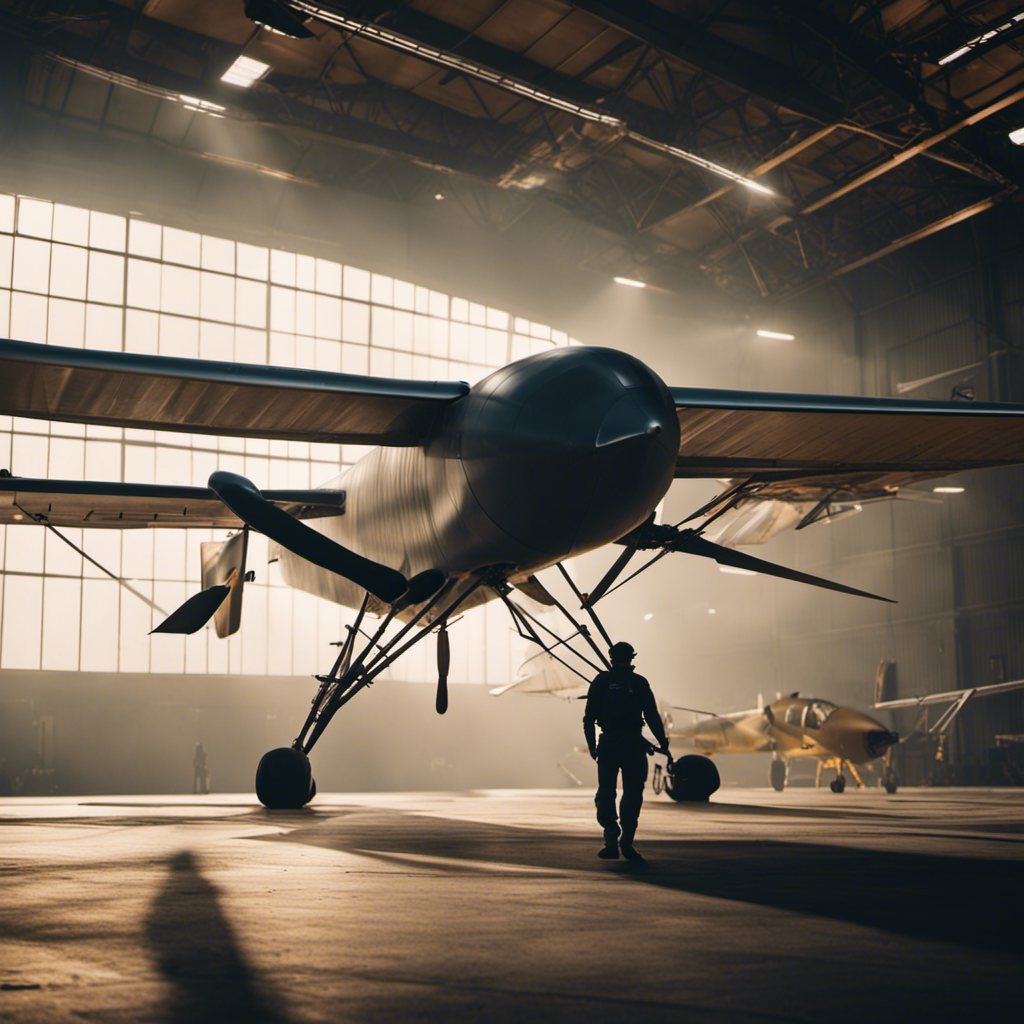As a glider pilot, I understand the importance of maintaining and inspecting our aircraft regularly. Just like a well-tuned machine, gliders require meticulous care to ensure their continued performance and safety.
In this article, we will delve into the maintenance and inspection requirements for gliders, covering everything from pre-flight checklists to annual inspections.
By following these guidelines, we can keep our gliders in optimal condition, ready to soar through the skies with confidence.
Let’s dive into the world of glider maintenance together.
Key Takeaways
- Regular maintenance is crucial for safe and efficient glider operation.
- Thorough pre-flight inspections are necessary to ensure the glider’s condition.
- Regularly scheduled inspections by certified mechanics are essential for optimal condition.
- Compliance with regulations is necessary to maintain airworthiness.
Required Maintenance Schedule
You’ll need to follow a required maintenance schedule for your glider. Proper maintenance is crucial to ensure the safe and efficient operation of your aircraft. Adhering to a regular maintenance routine will help identify any potential issues before they become major problems.
The first step in maintaining your glider is to establish a thorough pre-flight inspection checklist. This checklist should include a visual examination of all critical components, such as the wings, control surfaces, landing gear, and fuselage. Additionally, you should inspect the engine and propeller for any signs of wear or damage.
Regularly scheduled inspections are also necessary to keep your glider in optimal condition. These inspections should be performed by a certified mechanic who is familiar with gliders and their unique requirements. During these inspections, the mechanic will conduct a comprehensive examination of all systems and components, checking for proper functionality and identifying any necessary repairs or replacements.
In addition to these routine inspections, there are specific maintenance tasks that must be completed at regular intervals. These tasks may include lubricating moving parts, cleaning air filters, replacing spark plugs or ignition wires, and checking fluid levels.
Following the manufacturer’s recommended maintenance schedule is essential for the longevity of your glider. Neglecting regular maintenance can lead to decreased performance and potential safety hazards. By diligently following the required maintenance schedule and addressing any issues promptly, you can ensure that your glider remains in peak condition for many flights to come.
Pre-flight Inspection Checklist
When it comes to ensuring the safety of a glider, there are several key points that need to be addressed.
First and foremost, conducting essential safety checks is crucial before each flight. This includes inspecting the aircraft’s control surfaces, landing gear, and fuel system.
Additionally, it is important to follow a detailed inspection procedure that covers all aspects of the glider, from its structure to its instruments.
Lastly, compliance with regulations is paramount in order to maintain airworthiness and ensure that all necessary inspections and maintenance are carried out according to established guidelines.
Essential Safety Checks
To ensure safe glider operations, it’s important to regularly perform essential safety checks. These checks are crucial in identifying any potential issues or malfunctions that could compromise the safety of the glider and its occupants.
Here are four key safety checks that should be performed:
-
Control Surface Functionality: Verify that all control surfaces, such as ailerons, elevators, and rudders, move freely and smoothly without any binding or excessive play.
-
Structural Integrity: Inspect the glider’s structure for signs of damage or deterioration. Look for cracks, corrosion, loose fasteners, and any other abnormalities that could affect the overall strength and integrity of the aircraft.
-
Instrumentation Calibration: Calibrate all instruments, including altimeters, airspeed indicators, variometers, and navigation equipment to ensure accurate readings during flight.
-
Emergency Equipment Inspection: Check emergency equipment such as parachutes and fire extinguishers for proper functioning and condition.
By performing these essential safety checks regularly, you can minimize the risk of accidents during glider operations.
Next section: Inspection Procedure Details
Inspection Procedure Details
During the inspection procedure, it’s important to thoroughly examine all control surfaces for any signs of damage or malfunction.
Start by visually inspecting each control surface, including ailerons, elevators, and rudder. Check for any visible cracks, deformations, or loose parts. Ensure that hinges are secure and undamaged. Pay close attention to the leading edge and trailing edge of each surface for any signs of wear or corrosion.
Next, perform a tactile inspection by running your hands along each control surface. Feel for any irregularities such as rough patches or dents that could affect their aerodynamic performance. Additionally, check the movement of each control surface to ensure they move freely and smoothly without excessive play.
If any damage is detected during the inspection, it’s crucial to report it immediately and have it repaired before further flight operations.
Remember that a thorough examination of all control surfaces is vital to maintaining safe and reliable glider operations.
Compliance With Regulations
Make sure you adhere to all regulations when operating a glider. Compliance with these regulations is crucial for maintaining the safety and airworthiness of the aircraft.
Here are four key areas where adherence to regulations is essential:
-
Weight and Balance: Ensuring that the glider’s weight and balance remain within specified limits is critical for stability during flight.
-
Inspection Intervals: Regular inspections must be performed at prescribed intervals to identify any potential issues or wear and tear that may affect the glider’s performance.
-
Maintenance Records: Accurate and up-to-date maintenance records must be kept, documenting all inspections, repairs, modifications, and component replacements.
-
Equipment Requirements: Gliders must be equipped with required safety equipment such as parachutes, fire extinguishers, navigation lights, and transponder.
By following these regulations diligently, you can ensure safe operations and contribute towards maintaining the airworthiness of your glider.
Now let’s move on to discussing post-flight inspection procedures…
Post-flight Inspection Procedures
After flying, you should conduct a thorough inspection of your glider to ensure its safety and airworthiness. This post-flight inspection is crucial in identifying any potential issues or damage that may have occurred during the flight. By following a systematic procedure, you can effectively assess the condition of your glider and address any necessary maintenance or repairs.
To begin, visually inspect the entire glider for any signs of damage or wear. Check the wings, fuselage, control surfaces, and landing gear for any cracks, dents, or loose fittings. Pay close attention to critical areas such as wing roots and control linkage points.
Next, examine the fabric covering for tears or punctures. Look for any signs of fraying or deterioration that could compromise the structural integrity of the glider. Inspect all seams and stitching to ensure they are secure.
Moving on to the cockpit area, check all instruments and controls for proper functionality. Test each control surface individually to ensure smooth operation without binding or excessive play. Verify that all switches and knobs are in their correct positions.
Don’t forget to inspect the parachute system if your glider is equipped with one. Ensure that it is properly packed and free from damage.
Finally, thoroughly clean your glider by removing dirt, debris, and insects from all surfaces. This will not only improve its appearance but also help preserve its performance capabilities.
Annual Inspection Requirements
To ensure the ongoing safety and airworthiness of my glider, I always make sure to have an annual inspection conducted by a certified professional. This is crucial in identifying any potential issues or maintenance needs that may have arisen over the past year.
Here are four key components of the annual inspection process:
-
Structural Inspection: The inspector will thoroughly examine the glider’s structure, including the wings, fuselage, and tail assembly. They will check for any signs of damage, such as cracks or dents, that could compromise the integrity of the aircraft.
-
Systems Check: All systems on board will be inspected to ensure they are functioning properly. This includes checking the electrical system, control surfaces, landing gear, and braking system. Any malfunctions or worn-out components will be identified and addressed promptly.
-
Documentation Review: The inspector will carefully review all relevant documentation pertaining to the glider’s maintenance history and logbooks. They will verify that all required inspections and repairs have been performed in accordance with regulatory standards.
-
Test Flight: After completing the physical inspection, a test flight will be conducted to assess the glider’s performance in flight conditions. This allows for further evaluation of its handling characteristics and any potential issues that may only become apparent during actual operation.
Component Wear and Tear Assessment
Assessing the wear and tear on the components is essential to ensure the continued airworthiness of my glider. As a pilot, I understand the importance of regular inspections and maintenance checks to keep my glider in optimal condition. The components of a glider are subjected to various forces during flight, such as aerodynamic loads, vibrations, and temperature changes. These factors can lead to wear and tear over time, which can compromise the overall performance and safety of the aircraft.
To assess component wear and tear, I begin by conducting a visual inspection before each flight. This involves carefully examining all external surfaces, including control surfaces, wings, fuselage, and landing gear for any signs of damage or excessive wear. I pay close attention to areas where stress concentrations are likely to occur.
In addition to visual inspections, I also rely on non-destructive testing techniques like ultrasonic testing or dye penetrant inspection to detect hidden cracks or defects in critical components such as wing spars or control cables. These tests enable me to identify potential issues that may not be visible during routine inspections.
To accurately assess wear and tear on specific components like bearings or hinges, I refer to manufacturer guidelines for recommended service life limits or replacement intervals. Regular lubrication also plays an important role in maintaining these components’ functionality while minimizing friction-induced wear.
Engine and Propeller Maintenance
Regular engine and propeller checks are crucial to keep my glider in optimal condition for safe flying operations. As a pilot, I understand the importance of maintaining these components to ensure smooth and efficient flight. Here are four key aspects that I focus on during my engine and propeller maintenance:
-
Oil Inspection: I regularly check the oil level and quality to ensure proper lubrication of the engine. This involves checking for any signs of contamination or excessive wear in the oil, as well as monitoring its viscosity.
-
Spark Plug Examination: The spark plugs play a vital role in igniting the fuel-air mixture within the engine cylinders. Hence, I inspect them regularly for signs of fouling or damage, such as carbon deposits or worn electrodes. If necessary, I replace them with new ones to maintain optimal combustion.
-
Propeller Alignment: Proper alignment between the engine and propeller is essential for efficient power transfer and minimizing vibrations during flight. To ensure this, I visually inspect the propeller hub and blades, checking for any signs of misalignment or damage.
-
Belt Tensioning: In gliders equipped with belt-driven engines, it is crucial to maintain proper tension in the belts to prevent slippage and maximize power transmission efficiency. Regular inspections help me identify any loose or worn-out belts that require adjustment or replacement.
By diligently carrying out these checks on my glider’s engine and propeller components, I can ensure their reliability while upholding safety standards throughout my flights.
Now let’s move on to discussing another critical aspect of glider maintenance – evaluating structural integrity.
Structural Integrity Evaluation
When evaluating the structural integrity of my glider, I pay close attention to any signs of wear or damage that could compromise its safety during flight. The structural components of a glider are crucial for its overall performance and safety. To ensure the continued airworthiness of my glider, I follow a thorough inspection process.
Firstly, I carefully examine the fuselage for any visible cracks or deformations. This includes inspecting the skin, frame, and joints. Any signs of corrosion or stress must be addressed immediately to prevent further damage.
Next, I assess the wings and control surfaces. I check for any loose fittings or damaged ribs that may affect their strength and rigidity. Additionally, I inspect the wing spars for signs of fatigue or cracking due to excessive loads.
The tail section is equally important in maintaining stability during flight. Therefore, I inspect the horizontal stabilizer and elevator for proper alignment and operation. The vertical stabilizer and rudder are also examined for any signs of wear or damage.
Furthermore, I pay attention to critical areas such as wing root attachments and control system linkages. These areas are prone to stress concentrations which can lead to failures if not properly maintained.
Lastly, all fasteners including bolts, nuts, screws are checked for tightness and security throughout the entire glider structure.
Avionics and Instrumentation Checks
When it comes to avionics maintenance, there are a few key tips that I have found to be quite helpful.
First and foremost, regular inspections and cleaning of the avionics components can go a long way in ensuring their proper functioning.
Additionally, it is essential to follow the manufacturer’s guidelines for instrument calibration to maintain accuracy and reliability.
Lastly, checking flight data regularly is crucial for identifying any anomalies or discrepancies that may require further investigation or troubleshooting.
Avionics Maintenance Tips
To keep your avionics in top condition, make sure you’re regularly checking for any signs of wear or damage. Avionics play a critical role in the safe operation of gliders, so it’s essential to maintain them properly. Here are four important tips for avionics maintenance:
-
Visual Inspection: Conduct a thorough visual inspection of all avionic components, looking for any cracks, loose connections, or signs of moisture ingress.
-
Functional Testing: Perform regular functional tests to ensure that all avionic systems are operating correctly. This includes checking communication radios, navigation equipment, and transponders.
-
Software Updates: Stay up-to-date with the latest software updates provided by the manufacturer. These updates often include bug fixes and performance enhancements that can improve the reliability and functionality of your avionics.
-
Environment Protection: Protect your avionics from extreme temperatures, humidity, and other environmental factors that could cause damage or malfunction.
Instrument Calibration Guidelines
Make sure you regularly calibrate your instruments to ensure accurate readings and reliable performance. Instrument calibration is a crucial step in maintaining the integrity of your glider’s avionics system. By calibrating your instruments, you can minimize measurement errors and ensure that the readings are aligned with the actual values. Here is a table outlining the recommended calibration intervals for common glider instruments:
| Instrument | Calibration Interval |
|---|---|
| Altimeter | Every 24 months |
| Airspeed Indicator | Every 12 months |
| Vertical Speed Indicator | Every 24 months |
| Turn Coordinator | Every 12 months |
Following these guidelines will help you maintain accurate instrument readings and enhance flight safety. Once you have calibrated your instruments, it is important to check flight data for any anomalies or inconsistencies. This ensures that the instrument readings remain accurate throughout each flight.
Checking Flight Data
You should regularly review your flight data to identify any anomalies or inconsistencies. It is important to analyze the data collected during each flight to ensure the safety and optimal performance of your glider.
Here are four key points to consider when checking your flight data:
-
Altitude Variation: Check for any sudden or unusual changes in altitude during the flight. This could indicate a problem with the glider’s instruments or potential airframe issues.
-
Speed Deviation: Monitor the speed data recorded during the flight and compare it with expected values. Significant deviations may suggest issues with the glider’s airspeed indicators or other components affecting its speed capabilities.
-
Flight Path Accuracy: Assess whether your actual flight path aligns with what was planned or expected. Any unexpected deviations from the intended route should be investigated further.
-
Sensor Calibration: Ensure that all sensors used to collect flight data are properly calibrated and functioning correctly. Inaccurate sensor readings can lead to false conclusions about the glider’s performance.
Emergency Equipment Inspections
Check if your emergency equipment is properly inspected before each flight. As a glider pilot, ensuring the safety of myself and my passengers is of utmost importance. In order to do so, I must adhere to strict maintenance and inspection requirements for my glider. When it comes to emergency equipment, such as parachutes or fire extinguishers, regular inspections are crucial.
Before every flight, I meticulously inspect my emergency equipment to ensure its proper functioning. This includes checking the integrity of the parachute straps and buckles, making sure there are no signs of wear or tear. I also examine the fire extinguisher to verify that it is fully charged and within its expiration date.
In addition to visual inspections, certain emergency equipment may require more thorough testing. For example, I perform regular deployment tests on my parachute to confirm that it opens correctly without any snags or malfunctions. By doing so, I can have confidence in its reliability in case of an actual emergency.
Maintaining accurate logbook documentation and record-keeping is essential when it comes to tracking the maintenance and inspection history of my glider’s emergency equipment. These records provide a comprehensive overview of all inspections performed, including dates and results. They serve as a valuable reference for future inspections and help me stay organized with regards to ongoing maintenance requirements.
Logbook Documentation and Record-keeping
When it comes to logbook documentation and record-keeping, there are three key points that I want to discuss.
Firstly, let’s talk about required logbook entries. These entries include important information such as flight time, maintenance performed, and any modifications made to the glider. It’s crucial to accurately record these details in the logbook to maintain a comprehensive history of the glider’s activities.
Secondly, compliance with regulations is essential. It’s important to ensure that all necessary information is recorded in the logbook and that it meets the requirements set forth by aviation authorities. This helps to ensure that the logbook is a reliable and valid source of information.
Lastly, let’s discuss the importance of accurate records. Accurate records are crucial for safety purposes. They provide a detailed history of the glider’s maintenance, which can help identify any potential issues or trends. By keeping accurate records, you can ensure that the glider is properly maintained and that any necessary repairs or inspections are carried out in a timely manner.
Required Logbook Entries
Ensure that all necessary logbook entries are made to comply with the maintenance and inspection requirements for gliders. This is crucial for maintaining the airworthiness of the aircraft and ensuring safe operations.
Here are four important logbook entries that must be completed:
-
Maintenance Entries: Document any maintenance performed on the glider, including repairs, replacements, and inspections. Include details such as date, description of work done, and name of person performing the maintenance.
-
Inspection Entries: Record all inspections conducted on the glider, such as annual inspections or pre-flight checks. Note any findings or discrepancies discovered during these inspections.
-
Flight Entries: Log every flight made by the glider, detailing takeoff and landing times, duration of flight, destination, and purpose of the flight.
-
Equipment Entries: Keep a record of any modifications or installations made to the glider’s equipment or instruments.
Compliance With Regulations
Keeping up with regulations is essential for maintaining the airworthiness and safety of the aircraft. As a pilot, it is my responsibility to ensure that my glider complies with all applicable regulations.
This includes adhering to maintenance and inspection requirements set forth by aviation authorities. These regulations outline specific tasks and intervals for inspections, checks, and servicing of various components. It is crucial to follow these guidelines meticulously to ensure that my glider remains in an airworthy condition.
Failure to comply with these regulations can lead to compromised safety and potential accidents. Regular inspections, routine maintenance, and adherence to regulatory requirements help identify any potential issues or defects before they become major problems, ultimately ensuring the continued safety and performance of my glider during flight operations.
Importance of Accurate Records
Accurate record-keeping is crucial for tracking and documenting essential information about the aircraft. Maintaining detailed records ensures that all maintenance and inspection requirements are met, promoting the safety and efficiency of gliders.
Here are four key reasons why accurate record-keeping is vital:
-
Compliance: By keeping accurate records, we can demonstrate compliance with regulatory standards, such as routine inspections, component replacements, and repairs.
-
Maintenance History: Detailed records allow us to track the maintenance history of the glider. This includes scheduled maintenance tasks performed, dates of service, and any issues or repairs encountered.
-
Performance Monitoring: Accurate records enable us to monitor the performance of the glider over time. By comparing data from previous inspections and maintenance tasks, we can identify trends or potential areas requiring attention.
-
Resale Value: Well-maintained gliders with comprehensive records often have higher resale value due to their documented history of care and compliance with regulations.
Effective record-keeping provides a foundation for ensuring compliance with regulatory standards in maintaining gliders.
Compliance With Regulatory Standards
Complying with regulatory standards is essential for maintaining glider safety. As a glider pilot, I understand the importance of adhering to these standards to ensure that my aircraft is in optimal condition and capable of performing at its best. The aviation industry has established strict guidelines and regulations that govern the maintenance and inspection requirements for gliders.
To emphasize the significance of compliance, let’s take a look at the table below outlining some key regulatory standards for gliders:
| Regulatory Standard | Description |
|---|---|
| Annual Inspection | A comprehensive inspection conducted once every 12 months to assess overall airworthiness and identify any potential issues or defects. |
| Pre-flight Inspection | A visual check performed before each flight to verify the general condition of the aircraft, including control surfaces, engine compartment, and landing gear. |
| Component Replacement | The replacement of critical components or parts according to their prescribed service life limits or manufacturer’s recommendations. |
| AD (Airworthiness Directive) Compliance | Compliance with mandatory directives issued by aviation authorities addressing specific safety concerns or required modifications for glider models. |
By following these regulatory standards diligently, we can ensure that our gliders remain safe and reliable throughout their operational lifespan. Regular inspections help us detect any potential problems early on, allowing us to address them promptly and prevent accidents or incidents.
Frequently Asked Questions
What Are the Penalties for Failing to Comply With the Maintenance and Inspection Requirements for Gliders?
If you fail to comply with the maintenance and inspection requirements for gliders, there can be penalties imposed. These penalties serve as a way to ensure that proper maintenance practices are followed to maintain safety standards.
It is important to adhere to these requirements to avoid any potential penalties or consequences that may arise from non-compliance. By meeting these obligations, we can guarantee the continued airworthiness of gliders and promote safe flying practices in the aviation industry.
Are There Any Specific Maintenance and Inspection Requirements for Gliders Operating in Certain Weather Conditions, Such as High Winds or Heavy Rain?
In certain weather conditions, like high winds or heavy rain, specific maintenance and inspection requirements are necessary for gliders. These requirements ensure the safety and performance of the aircraft during challenging flying conditions.
Proper checks and upkeep are crucial to prevent accidents or damage caused by adverse weather. By adhering to these guidelines, pilots can confidently navigate through turbulent skies and unpredictable elements, ensuring a smooth flight experience despite the inclement weather.
Can Glider Owners Perform Their Own Maintenance and Inspections, or Is It Required to Be Done by a Certified Professional?
Yes, glider owners can perform their own maintenance and inspections. However, it is highly recommended to have a certified professional conduct these tasks. They possess the necessary expertise and knowledge to ensure that all maintenance and inspections are carried out correctly and in compliance with regulations.
Additionally, professionals have access to specialized equipment and resources that may be required for certain maintenance procedures. Ultimately, entrusting these responsibilities to a certified professional ensures the safety and airworthiness of the glider.
What Are the Recommended Methods for Storing Gliders During Periods of Inactivity, Such as During the Winter Months?
During periods of inactivity, such as the winter months, it’s crucial to properly store gliders to ensure their longevity and safety.
One recommended method is to store them in a cool, dry place, away from direct sunlight or extreme temperatures.
It’s also important to cover the glider with a protective covering or tarp to prevent dust accumulation and potential damage.
Additionally, regular inspections should be conducted before storing and after prolonged periods of inactivity to identify any potential issues that may require maintenance.
Are There Any Specific Guidelines for Inspecting and Maintaining the Tow Ropes Used for Launching Gliders?
Yes, there are specific guidelines for inspecting and maintaining the tow ropes used for launching gliders.
It is important to regularly check the condition of the rope, looking for signs of wear or damage such as fraying or knots.
Additionally, the strength and integrity of the rope should be tested to ensure it can withstand the forces exerted during launch.
Regular cleaning and lubrication are also necessary to maintain optimal performance.
Following these guidelines will help ensure safe and efficient glider launches.
Conclusion
In conclusion, ensuring the maintenance and inspection requirements for gliders are met is crucial for safe and efficient operation. By following the required maintenance schedule, conducting pre-flight and post-flight inspections, and performing annual inspections, glider pilots can comply with regulatory standards. Additionally, assessing component wear and tear, checking avionics and instrumentation, inspecting emergency equipment, and maintaining accurate logbook documentation are all important tasks. It is interesting to note that according to a recent study by the Federal Aviation Administration (FAA), 75% of accidents involving gliders were attributed to inadequate maintenance or insufficient inspections. Therefore, adhering to these procedures is essential in preventing avoidable incidents.




